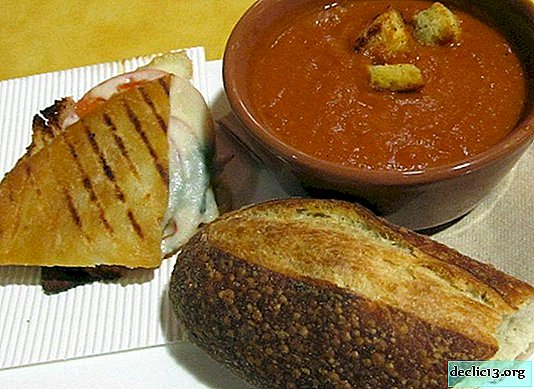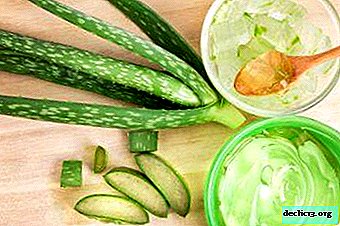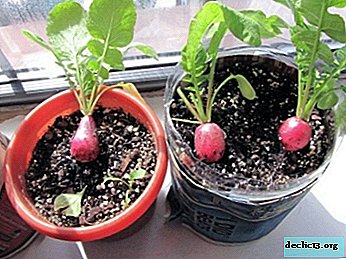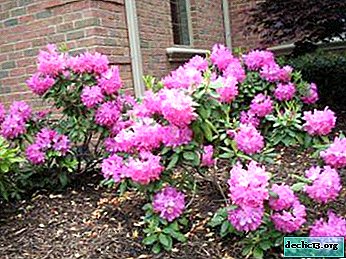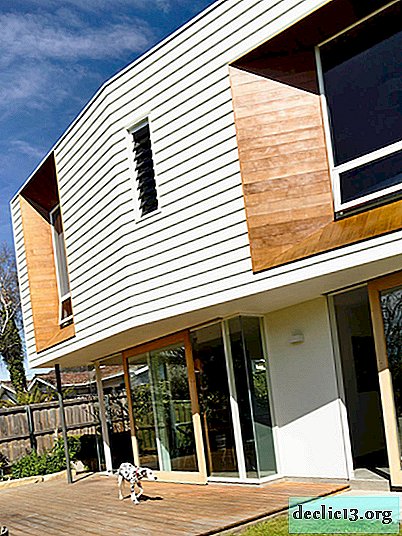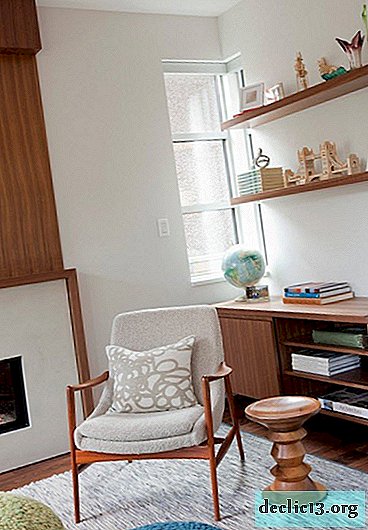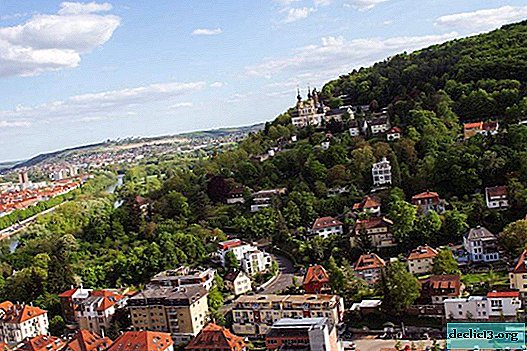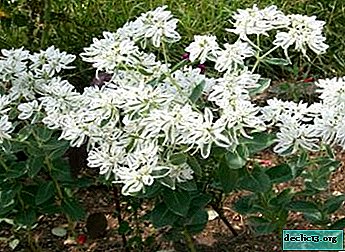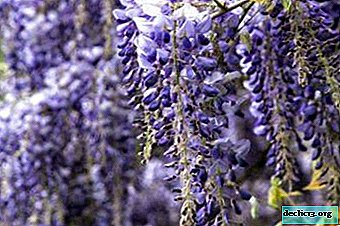Carolinsky hybrid rhododendron pjm elite and crystal baby: description and care
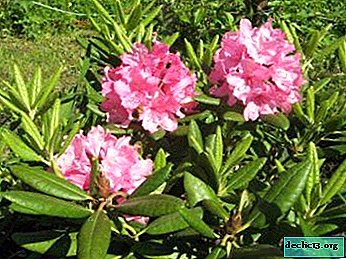
Many summer residents and gardeners dream of beautiful flower beds. We can say that not so long ago began an active fascination with this amazing plant. At first, Rhododendron seemed something unrealistic, it was hard to imagine that it would be possible to easily plant it on its site and it would grow. But, as they say, eyes are afraid, and hands do, now various species are successfully grown in almost all countries of the world. The main thing is that you need to choose the right rhododendron variety for your climate zone and grow it for your own pleasure. In this article you will find useful information about this amazing flower.
Brief Definition of the Hybrid Variety
Rhododendron Karolinsky - evergreen shrub of the heather family, refers to frost-resistant species (read in general about evergreen rhododendrons here). Under natural conditions it grows in the foothills and on the slopes of the mountains of South and North Carolina, Alabama and Georgia.
Detailed description
This shrub reaches a height of 1.5 meters, it has a wide round crown. It grows slowly, not more than 4 - 5 cm per year, photophilous. His life expectancy is 30 years.
- Leaves - dense, dark green, covered with scales on the underside. 8-10 cm grow in length, 4 cm in width, rounded at the end.
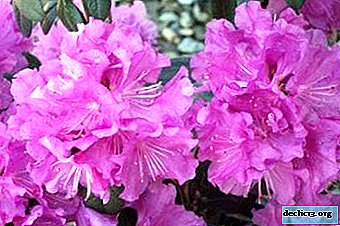 Flowers - funnel-shaped, medium-sized (about 4 cm in diameter), in inflorescence usually there are 8 - 9 pieces. Their color is usually white or pink. Flowering begins in May and lasts, on average, about 3 weeks.
Flowers - funnel-shaped, medium-sized (about 4 cm in diameter), in inflorescence usually there are 8 - 9 pieces. Their color is usually white or pink. Flowering begins in May and lasts, on average, about 3 weeks.- Trunk - the bark is light brown in color, young branches are first green, easily bend, then wood.
- Root system - superficial.
- Fruit - bolls with seeds, ripen in September.
What are the other species?
This the variety is distinguished from the rest by its high winter hardiness and compact bush form.
History of occurrence
The variety was introduced to Europe at the end of the 18th century, and in Russia this species appeared in 1970.
The first copy of Rhododendron was obtained from seeds that were sent to biologists from Amsterdam.Subcort
Crystal baby
Dwarf variety (not higher than 90 cm) with white or white - pink delicate flowers. They are collected in inflorescences of 6 or 8 pieces. Crohn spherical shape.
Pjm elite
This is a small spherical small-leaved shrub. (strong density appears on the 4th year), raspberry - pink flowers are collected in small inflorescences of 6 pieces; its height (as well as width) does not exceed one meter.
Bloom
- When and how - flowering begins in May and lasts about three weeks.
- Care before and after flowering - Naturally, you need to take good care of Rhododendron before an important phase of his life. In April, fertilizer must be added, you can use water infusion of rotted cow manure (the most useful organics). To control watering, try not to overfill, but also eliminate the lack of water, as soon as the topsoil becomes dry, you can water it.
- Water should not be hardIt’s best to just rain water. After flowering, we do the same, but still need to cut the flower stalks, otherwise the flowering will not be so intense next year.
- What to do if it does not bloom - It’s worth replanting it to another place, most likely, the soil does not suit him, maybe it turned out to be too dense for him and the roots are suffering.
Use in garden design
Rhododendron fits perfectly into any group planting of other types of Rhododendrons. It is very versatile due to its size. It will also look very good along the path (you can drop a whole row), next to the gazebo. And from this shrub you can make bright spots on the lawn - a great scenic option.
Step-by-step care instructions
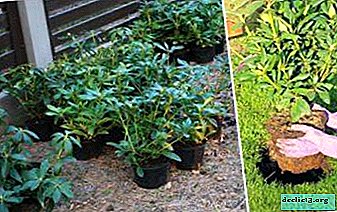 Choosing a landing place - this, you can say, is the most important step, because, on the one hand, this handsome man must be on public display to admire him, and, on the other hand, he must be protected from bright sunlight and strong winds. Therefore, there is no need to rush, but you should carefully consider all available options and choose the most successful one.
Choosing a landing place - this, you can say, is the most important step, because, on the one hand, this handsome man must be on public display to admire him, and, on the other hand, he must be protected from bright sunlight and strong winds. Therefore, there is no need to rush, but you should carefully consider all available options and choose the most successful one.Light should be diffused into the bush and it should be protected from drafts. Well, if there is a pond on the site - it would be great to place it nearby - the necessary humidity will be set by itself.
- What should be the soil - it should be light, slightly acidic. It’s rare where you will find ready-made, well-drained, loose fertile soil, so we prepare it ourselves. It is necessary to mix in equal parts horse peat, sand, humus, turf, perlite and add a little fine coal. As a result, we get a perfect substrate for our Rhododendron.
- Landing - It is best to do planting in the spring (April or May).
- We prepare a pit for planting, moreover, it should be about 2 times the volume of the root system of the bush.
- We fill it with the prepared substrate (not to the top) and plant the plant strictly vertically.
- Next, we fall asleep with the same substrate carefully, trying not to damage the thin roots, but tamping slightly, the voids do not need to be left.
- Well watered, the entire lump of land should be well saturated with water, lay on top of the mulching layer of pine bark. Before planting, you can put the bush in a container of water, the roots are nourished with water and adapt more easily.
- Temperature - this frost-resistant Rhododendron is able to withstand frost up to 28 degrees and heat up to 30 degrees. The temperature from minus 10 to plus 20 degrees will be suitable for him.
- Watering - “lovers” of water often want to drink, so do not allow drought in any case. Usually it is 1 or 2 times a week, when it's cool, then, of course, water less often. Only soft water will do.
- Top dressing - Of course, needed, but in moderation. Three top dressings are obligatory - at the beginning of spring, at the beginning of flowering and after flowering. It is good if it is organics (peat and high-grade humus), but it is possible to fertilize with minerals - only special ones for Rhododendrons.
- Pruning - you don’t need to do it without the need, the bush itself perfectly forms its crown, remove only dried and broken branches. But flower stalks must be removed!
- Transfer - Naturally, it may be required, it is best to do it in the spring or summer after flowering. As with planting, you will need to prepare the substrate and then perform all necessary manipulations. A newly transplanted plant should not be fed until the next season.
- How to prepare for winter - so that in winter the plant does not experience difficulties, be sure to spill it well when low temperatures occur (about 2 - 3 degrees Celsius). It is also required to add a good layer of mulch (about 12 - 15 cm) and prepare a covering material. When negative temperatures are established, we cover the shrub with a spanbond.
To visually see how to properly land the Rhododendron, you can watch the video:
How to propagate?
It is most convenient to propagate Rhododendron by layering, although, it is possible, by horse, and in other ways - by seeds or cuttings. Simply when propagating by layering, less labor is required - In the spring, we dig in the lower branch (we strengthen it so that it does not move) and do not forget to water. Next spring we will have our own rooted seedling, which is ready for planting.
Diseases and Pests
The most common pests:
- Aphid - very quickly attacks the plant, sucks the juice from leaves and buds. If detected, immediately treat with any fungicide.
- Spider mite - a very small insect, but it can do much harm, feeds on the sap of the plant, gradually dragging out its leaves with its cobweb. The treatment with Diazinon will help.
- Mealybug - Covers the surface of the leaves with a white coating, multiplies very quickly. Helps "Karbofos."
May also appear: mosaic and chlorosis.
Prevention of various problems
To avoid all kinds of problems - diseases or pests, of course, the main thing is to try to properly care for your Rhododendron. You can still help to process 2 to 3 times with Bordeaux liquid.
Conclusion
The conclusion can be drawn as follows - Rhododendron confidently withstands competition in comparison with its more capricious counterparts. It tolerates frosty winters and feels good in hot summers. Due to its compactness and low growth, it (or better several) can be placed in the garden in any convenient place - to settle in a multi-colored "balls" and enjoy their flowering.

 Flowers - funnel-shaped, medium-sized (about 4 cm in diameter), in inflorescence usually there are 8 - 9 pieces. Their color is usually white or pink. Flowering begins in May and lasts, on average, about 3 weeks.
Flowers - funnel-shaped, medium-sized (about 4 cm in diameter), in inflorescence usually there are 8 - 9 pieces. Their color is usually white or pink. Flowering begins in May and lasts, on average, about 3 weeks. Choosing a landing place - this, you can say, is the most important step, because, on the one hand, this handsome man must be on public display to admire him, and, on the other hand, he must be protected from bright sunlight and strong winds. Therefore, there is no need to rush, but you should carefully consider all available options and choose the most successful one.
Choosing a landing place - this, you can say, is the most important step, because, on the one hand, this handsome man must be on public display to admire him, and, on the other hand, he must be protected from bright sunlight and strong winds. Therefore, there is no need to rush, but you should carefully consider all available options and choose the most successful one.